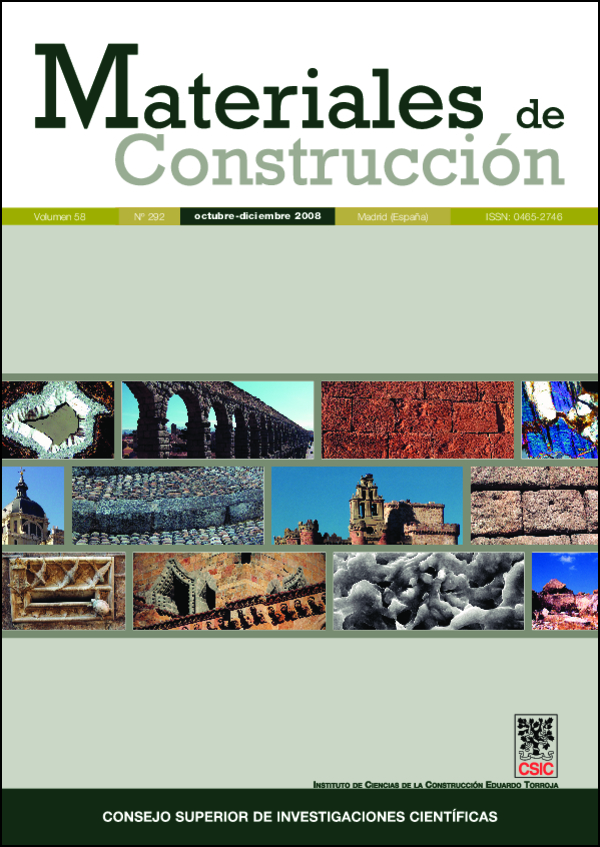The basic construction materials industry and today’s vast housing shortage
DOI:
https://doi.org/10.3989/mc.2008.46408Keywords:
need for materials, cement production, “informal” sector, impact of the cost of materials, Third WorldAbstract
This paper documents some of the aspects of the major challenge facing world-wide building: humanity's daunting shortage of basic housing, monographically focusing on what this means for the basic building materials industry. These needs have created the greatest demand ever for ex-novo solutions and an exponential increase in slum rehabilitation and improvement, translated here into the need for construction materials and more specifically, cement, as the emblematic component of buildings.
Downloads
References
(1) WACLA: 1996, World Assembly of Cities and Local Authorities: Soluciones locales y problemas globales: El futuro de los asentamientos humanos. Estambul 31.05. (1996).
(2) Tibaijuka, A.: 2007, “Ante el Día Mundial del Hábitat”, UN - HABITAT, Nairobi, 12.05.2007
(3) Naciones Unidas: 2003, World Population Prospects: The 2002 Revision. Nairobi, 2002.
(4) COHRE: 2003, Centre on Housing Rights and Evictions, Global Survey nº 8, Ginebra Suiza.
(5) UN HABITAT: 1996, United Nations Centre for Human Settlements (Hábitat): Informe Mundial sobre los Asentamientos Humanos, ISBN 92-1-331015-3.
(6) Mac Donald, J.: “Pobres en ciudades pobres”, ponencia en el I Congreso Internacional sobre Desarrollo Humano, Ayuntamiento de Madrid, nov. (2006).
(7) UN HABITAT 2003, “Improving the lives of 100 million slum dwellers”, Global Observatory, Un-HABITAT, Nairobi (Kenya).
(8) Banco Mundial: 2005, World Development Indicators: http://www.worldbank.org/poverty/wdrpoverty
(9) Millenium Project: 2006, Mejorar las condiciones de vida de los chabolistas, Un hogar en la ciudad, Ministerio de Vivienda (España), Madrid, (2007).
(10) ONUDI: First Consultation on Building Material, Atenas, marzo (1985).
(11) Ortega y Gasset, J.: “Meditación de la técnica”, Charla en Buenos Aires, 1952. Edit. Alianza, Revista de Occidente, Madrid (2000).
(12) Salas, J.: La industrialización “posible” de la vivienda latinoamericana. Edit. ESCALA, Bogotá, Colombia (2000). (13) Gonçalves, R.: “Documento sobre situaçao atual da habitaçao na Regiao Metropolitana de Belo Horizonte” (1997), mimeo.
(14) Torrealba, E.: “Construcción de viviendas de bajo coste en Chile: el caso de Rancagua”, CEPAL (1999).
(15) O.P.E. El Salvador, Oficina de Planificación Estratégica de El Salvador: “Propuestas para la transformación de los procesos de gestión de proyectos y análisis de casos en viviendas” (1997).
(16) Houben, H. L.: “habitat èconomique dans les pays en developpemenr: materiaux, techniques de constructio. Plan Construcción. Paris (1993), Vol. 2 págs. 53 a 56.
(17) Cortinez, J. M.: Los materiales de construcción: Base industrial de la producción de vivienda, Cap. 4 “La producción de la Vivienda en América Latina”, CEPAL, Santiago de Chile (1996). (19) Gastelum, G.: Director de Comunicaciones Externas de Apasco, Cemex (2007). Comunicado del 7.09.2007.
(20) USGS: Mineral Yearbook (2002).
(21) Banco Mundial: World Development Report, 2000/2001 Attacking poverty (2001) http://www.worldbank.org
(22) CEPAL: Alojar el Desarrollo: Una tarea para los asentamientos humanos. Documento LC/L906. CONF. 85/3. Ver: Julián Salas, Actas de la Reunión CYTED: Iberoamérica ante Hábitat II. Ministerio de Fomento, Madrid (1996).
(23) Ganesan, S.: “Employement maximization in construction in developing countries”. Construction Management and Economics, Nº. 12, pp. 323-335 (1994). doi:10.1080/01446199400000042
(24) Salas, J.: “Respuestas a la Primera Consulta sobre la industria de los Materiales de Construcción de ONUDI”, Mater. Construcc., Vol. 35, Madrid (junio 1985).
(25) Rodríguez, E., Bernal, S., Mejía de Gutiérrez, R., Puertas, F.: “Hormigón alternativo basado en escorias activadas alcalinamente”. Mater. Construcc., vol. 58, nº 291, pp. 53-67 (2008).
Downloads
Published
How to Cite
Issue
Section
License
Copyright (c) 2008 Consejo Superior de Investigaciones Científicas (CSIC)

This work is licensed under a Creative Commons Attribution 4.0 International License.
© CSIC. Manuscripts published in both the print and online versions of this journal are the property of the Consejo Superior de Investigaciones Científicas, and quoting this source is a requirement for any partial or full reproduction.
All contents of this electronic edition, except where otherwise noted, are distributed under a Creative Commons Attribution 4.0 International (CC BY 4.0) licence. You may read the basic information and the legal text of the licence. The indication of the CC BY 4.0 licence must be expressly stated in this way when necessary.
Self-archiving in repositories, personal webpages or similar, of any version other than the final version of the work produced by the publisher, is not allowed.
















